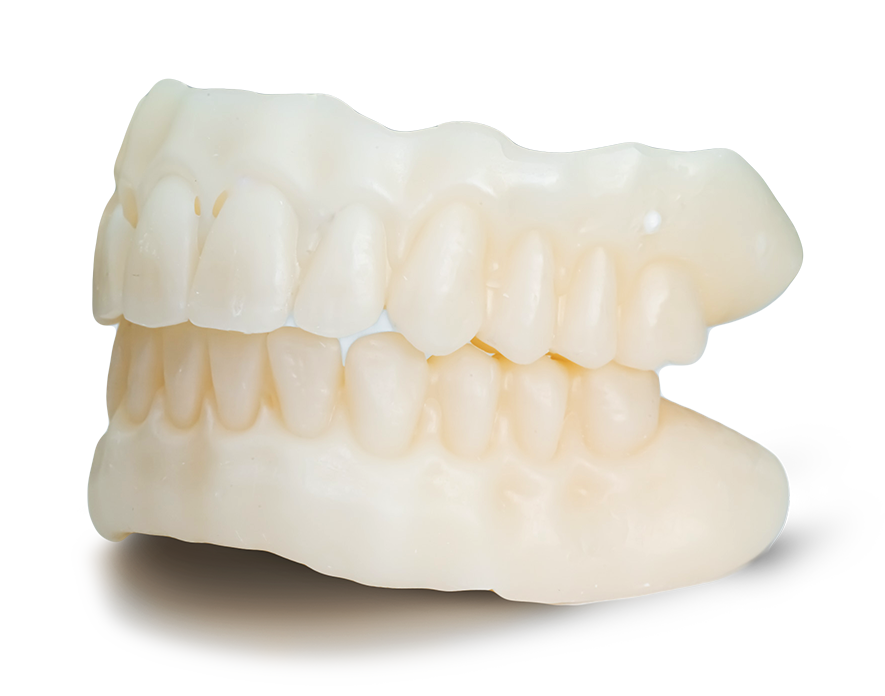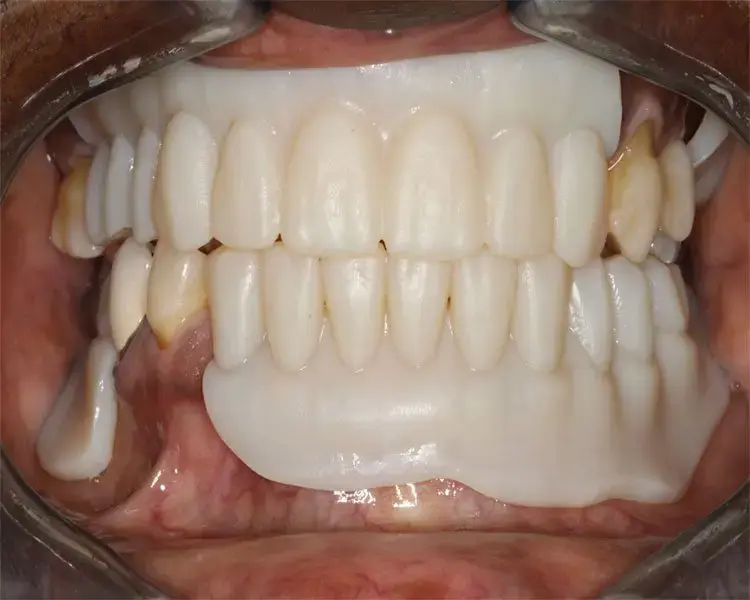- Home
- Products
- CHROME GuidedSMILE
- Pre-Surgical Decisions
- The JC Try-in™
The JC Try-in™
The JC Try-In represents a significant advancement in bite registration and confirmation for complex full-arch cases.
This digitally designed and 3D printed orthotic appliance addresses the limitations of traditional bite blocks and bite rims, particularly in challenging clinical situations where patients present with closed bites requiring opening beyond the standard 3mm articulator limitation, or cases involving patients with few or no centric stops where vertical dimension needs to be determined and confirmed.
Unlike conventional bite registration methods, the JC Try-In seats like a flipper or partial denture, allowing patients to experience and adapt to their new vertical dimension and bite position before final treatment.
This innovative approach provides superior accuracy in establishing proper occlusion and enables precise bite confirmation, making it an invaluable tool for cases requiring significant bite opening of 10 millimeters or more, while giving both doctor and patient confidence in the planned treatment outcome.


Clinical Benefits of the JC Try-in
Enhanced Accuracy
- More accurate bite registration than traditional bite blocks and bite rims
- Precise vertical dimension establishment in complex cases
- Eliminates guesswork in challenging bite confirmation scenarios
Complex Case Solutions
- Handles bite opening beyond standard 3mm articulator limitations
- Effectively manages patients with few or no centric stops
- Addresses significant vertical dimension changes of 10+ millimeters
Improved Patient Experience
- Seats like a familiar flipper or partial denture for better acceptance
- Allows home wear for gradual adaptation to the new bite position
- Reduces patient anxiety about dramatic bite changes
Streamlined Clinical Workflow
- Enables chairside adjustments and equilibration to ideal occlusion
- Supports flexible bite registration techniques (sectional or full arch)
- Digitally designed and 3D printed for consistent results
Treatment Planning Advantages
- Provides definitive records for accurate case mounting and planning
- Bridges the gap between initial assessment and final prosthetic delivery
- Reduces the need for multiple bite registration appointments
JC Try-In Operational Instructions
When JC Try-In is used
- When a closed bite requires opening for the procedure, usually more than the 3 mm recommended limitation of the articulator.
- When patients present with few or no centric stops when the vertical needs to be determined and confirmed.
- When the bite confirmation is needed, as well as a scan appliance - can be for both.
Records Needed
- Master casts, PVS or digital impressions, and a bite registration
- Retracted photographs of the patient biting in centric, left, right, and straight on
How to Use
- Seat the JC Try-In into position
- Equilibrate until the centric and VDO are confirmed
- When equilibrating, leave cusp tip indentations in the JC Try-In to give the patient definitive landing spots
- Capture a bite registration and return both the JC Try-In and the bite to ROE for re-articulation
Download Your Free Ultimate Restorative Protocol Guide Now
What You'll Gain In This 70-Page Guide:
- Step-by-step instructions for ten digital and analog restorative protocols
- Complete understanding of all necessary patient record requirements on a per-patient scenario
- Detailed comparison charts for informed decision-making between protocols
Available in digital or print format (free mailing included).

Video Resources
The JC Try-in Scan Appliance
The JC Try-in
The JC Try-In: The Best Method for Evaluating a Patient's Bite Records
Simple Patient Records Webinar - JC Try-In
Frequently Asked Questions
Frequently Asked Questions
Have question? We are here to help

No results found.
The JC Try-In is a digitally designed and 3D printed orthotic appliance that seats like a flipper or partial denture, used to confirm and establish the patient's bite position.
Full Surgical Guide Offerings - Product Comparison
| Price | Days in Lab | Guided Kits | No. of Sites | Application | |
|---|---|---|---|---|---|
| Tooth Supported | $$ | 3 days planning 4 days production |
All | 1-6 | Printed surgical resin, with Ti sleeves or sleeveless |
| Tissue Supported | $$ | 4 days planning 4 days production |
All | Any Number | Edentulous cases where guide is based on a dual-scan |
| Bone Supported | $$$ | 4 days planning 5 days production |
All | Any Number | Best for edentulous cases where dual-scan is not an option. Optional open channel for bone leveling |
| CombiGuide | $$$ | 5 days planning 5 days production |
All | Any Number | Full arch all-metal guide, but limited to bone reduction and implant placement |
| CHROME GuidedSMILE | $$$$ | 5 days planning 10 days production |
All | Any Number | Fully-guided All-on-X surgery & restoration. |
How can we help you today?
Can't find what you're looking for? No problem. Let us help.
ROE’s experts are dedicated to elevating your dental practice.
- Full-service national dental laboratory
- Comprehensive Certified Dental Laboratory (CDL) services
- Case planning support from 20+ Certified Dental Technicians
- Specialists in both fixed, removable, implant and full-arch dentistry
- Tailored support for all cases, from routine to complex
- National Association of Dental Laboratories (NADL) member
- Only FDA-approved materials used
- All products made in the USA
- Thousands of free online education materials




